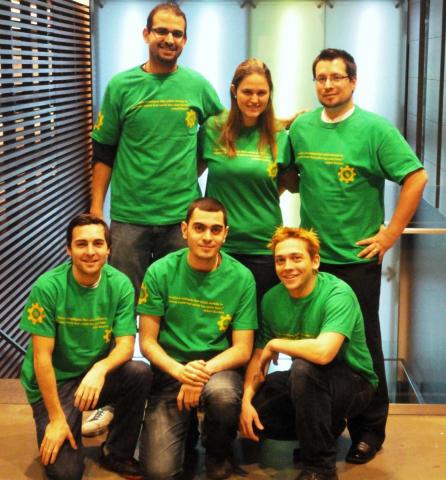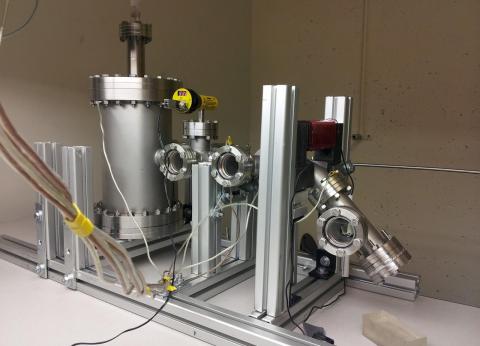

With TRIUMF immersed in building a fully functioning electron accelerator by 2014 or so, it is rather ironic that one of our former co-op students, Nick Zacchia, beat us to the punch. Nick Zacchia and his teammates from Concordia University recently built a very small, though entirely functional electron accelerator as the Capstone project for their Mechanical Engineering degree. What makes this so impressive is that no one expected it to work as well as it did, or at all. Nick recalled that, while he was in Vancouver working at TRIUMF, the rest of his Capstone team was trawling the Concordia campus, seeing if professors had anything in particular that they wanted built. “[My teammates] were talking to a professor and he said, ‘Okay, I’ve got this project or that project or, if you’re feeling really ambitious, I’ve got this crazy idea about building an electron accelerator, if you guys are interested.’” They were. Nick added that, “it was one of those dreams [the professor] had been hoping for, but never had the funding, and he figured, ‘let’s see if these kids can do it.’” Six months later, it turned out that they could.
The six-month process began with a proposal in August 2011. Once approved, design began in September 2011 and lasted until the end of January 2012. In December 2011, near the end of the design phase, they began to manufacture the device until March 26, 2012, when they turned it on for the first time. Upon turning the device on, it produced an electron beam. “It wasn’t perfect from the start,” Nick admitted, “but it worked very nicely from the get-go; it worked better than anyone expected, I think.”
Distilling an intensive six-month project into a relatively short paragraph makes it sound easy, but it was far from it. In fact, Nick and his team seemed to be breaking new ground on the Concordia campus: “we went to various people in the university to ask for advice and for help and a lot of them just looked at us and said, ‘you know what? I don’t know.’” Despite the scarcity of information on campus, Nick said he did find two physics technicians who were indispensible to the project: “I would go to them and ask them this and that,” Nick said. “At a certain point, when we got close to the final design, they said to me, ‘listen, you have tapped all the knowledge we have of accelerators and physics. After this, you’re on your own.’” After he and the rest of the Capstone team had exhausted the knowledge of the physics technicians, they relied on research and simulations to see the project through to completion.
Nick modeled the BL 2C-1 proton beam line for Proton Therapy and PIF and NIF during his co-op semester at TRIUMF, and he credits a great deal of the project’s success to his time at TRIUMF. Being an engineering student, Nick said that he didn’t have much of a background in physics, but being at TRIUMF enkindled his interest in physics. “Being at TRIUMF opened my eyes to everything that’s out there in physics,” Nick said. “It really sparked my interest and inspired me to go further to pursue this. Even as an engineering student, I felt at home there. I felt comfortable with the topics that were being discussed. Being at TRIUMF gave me the background knowledge that I needed to build this accelerator.”
Not only did Nick’s time at TRIUMF provide him with valuable knowledge, it also provided him with an atmosphere characterized by support and inquisitiveness that allowed him to flourish. Early on in his co-op term, Nick told his supervisor, Mike Trinczek, that he wanted to attend every lecture offered at TRIUMF. “He said, ‘Yeah. Go for it.’ He was very supportive of that. He taught me that the point of TRIUMF is to further knowledge, to do research, to do science,” Nick said. “That really stuck with me.” Nick said he received a great deal of support during his semester at TRIUMF, specifically from Mike Trinczek and Conny Hoehr.
Nick graduates from Concordia in a few weeks and his experience at TRIUMF and with the electron accelerator seem to have informed his future educational path as he considers graduate school. “I definitely want to do more science,” Nick said. “I want to study nanoscience. I want to apply experimental physics to the study of nanoscience.”
When asked to sum up his experience as a co-op student at TRIUMF, Nick’s response was tremendously positive, saying, “[It] was the best co-op job, not only that I’ve ever had, but the best you could ever ask for. If you’re interested in physics or any kind of science, I could not possibly foresee a better place to go than TRIUMF. It was interesting. The people were supportive. The atmosphere was so amazing.”
The electron accelerator itself is formally known as the Mini Electron Gun Accelerator (MEGA) and it operates up to 50keV. Its purpose, according to the Concordia University website, is to “bombard an electrolytic solution with an electron beam (typically 10-100eV in the electrolyte,” which will “provide a research tool to allow the fundamental study of the highly reducing solvated electron in aqueous electrolytes.”
You can learn more about Nick, his teammates, and the individual components that make up the MEGA here. You can see the MEGA at the Canadian Undergrad Tech Conference (Toronto, April 28-29), and at the CSMU/CSME (Manitoba, June 24-25). Nick and his team will also be competing for the Canada-wide Capstone Award.
Electron Accelerator Capstone Team: Jad Saleh, Nick Zacchia, Stephen Jacobs, Giovanni Fancello, Sabrina Ibarra, Andrew Farag.
--Written by Jordan Pitcher, Communications Assistant
